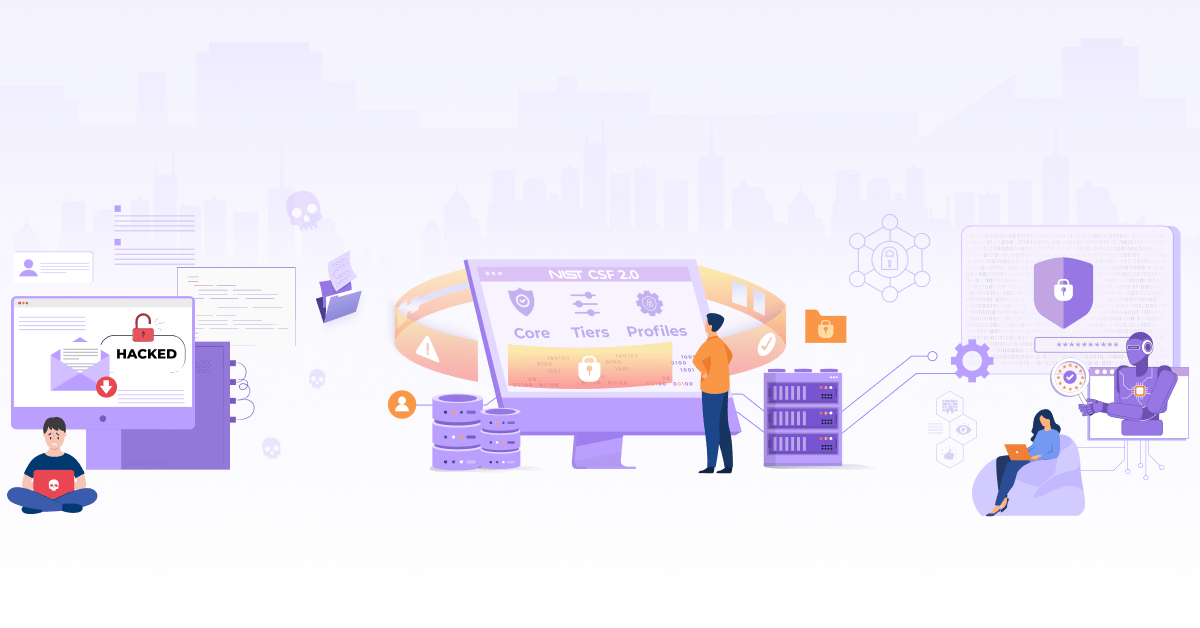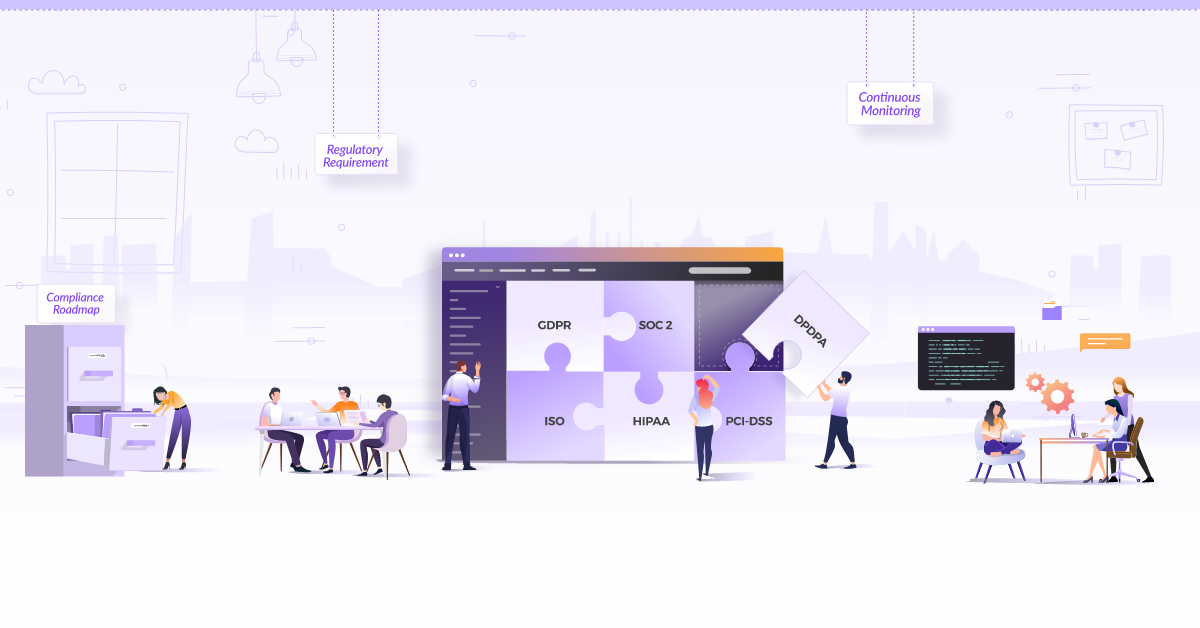
A Comprehensive Guide to Achieving SOC 2 Compliance

Data security and privacy are one of the top priorities for organizations and their clients in the current digital era. Industry standards and regulatory frameworks have been developed to make sure that businesses manage sensitive data appropriately. The SOC (System and Organisation Controls) 2 is one such standard.
Obtaining SOC 2 compliance demonstrates an organization’s commitment to data security and privacy, which can enhance trust and confidence among customers and partners. It’s particularly relevant for businesses that handle sensitive or private data, such as technology, healthcare, finance, and other sectors. In this blog post, we’ll define SOC 2 compliance and walk you through the various phases and processes you can follow to achieve it.
What is SOC 2 Compliance?
SOC 2 is a framework developed by the AICPA (American Institute of Certified Public Accountants) to assess the various trust service principles, which are Security, Availability, Processing Integrity, Confidentiality, and Privacy of customer data stored in cloud-based systems and data centers. It provides a set of criteria that organizations must meet to demonstrate their commitment to data security and privacy. Achieving SOC 2 compliance not only reassures customers about the security of their data but also enhances an organization’s overall cybersecurity posture.
Organizations that undergo SOC 2 compliance assessments are evaluated based on these principles, and an independent auditor assesses their adherence to the stated criteria. The resulting SOC 2 report assures stakeholders, such as customers, that the organization has established and implemented effective controls to meet these principles.
SOC 2 reports come in two main types: SOC 2 Type 1 and SOC 2 Type 2. These reports provide information about an organization’s control environment, specifically regarding the five trust service principles (Security, Availability, Processing Integrity, Confidentiality, and Privacy).
| SOC 2 Type 1 | SOC 2 Type 2 | |
|---|---|---|
| Description | A SOC 2 Type 1 report evaluates an organization’s systems and controls at a specific point in time. It provides a snapshot of the controls in place as of a specific date. | A SOC 2 Type 2 report goes beyond a Type 1 report by reviewing the controls over time, often for at least six months. It evaluates if the controls have been successful during this time period and how well they have been doing. |
| Purpose | Type 1 reports are often used by organizations or their customers to assess the design and implementation of controls. They help stakeholders understand what controls are in place and how they are intended to work. | Type 2 reports provide a more comprehensive assessment of an organization’s control environment. They are often sought by customers and stakeholders who want assurance that the controls are not only designed appropriately but are also functioning effectively over time. |
| Time Period | Type 1 reports cover controls and their effectiveness at a specific date, typically a single day or moment in time. | Type 2 reports cover controls and their effectiveness over a specified period, typically six to twelve months. |
How to achieve SOC 2 Compliance?
As we know what SOC 2 compliance is and its importance, let’s see how your organizations can achieve it. The 9 steps of achieving SOC 2 compliance are:
- Understand your scope
- Select the right trust service criteria
- Perform a gap assessment
- Develop policies and procedures
- Implement security controls
- Monitor and audit
- Engage a third-party auditor
- Remediate and improve
- Maintain ongoing compliance
Let’s understand each one in detail.
Step 1: Understand your scope
It’s crucial to establish the scope of your assessment before starting the route toward SOC 2 compliance. The systems, applications, and data that are pertinent to the services offered by your organization must be identified. The compliance procedure will be easier to handle if the scope is reduced. The scope is generally called system description, and it is divided into various description criteria (DC). Below are the various description criteria that we have to include in our system description document as per AICPA official documentation:
DC1: The types of services provided by the organization (SAAS, PAAS, etc.).
DC2: The principal service commitments and system requirements.
DC3: The components of the system used to provide the services, including the following:
a. Infrastructure
b. Software
c. People
d. Procedures
e. Data
DC4: For identified system incidents that (a) were the result of controls that were not suitably designed or operating effectively or (b) otherwise resulted in a significant failure in the achievement of one or more of those service commitments and system requirements, as of the date of the description (for a type 1) or during the period of time covered by the description (for a type 2), as applicable, the following information:
a. Nature of each incident
b. Timing surrounding the incident
c. Extent (or effect) of the incident and its disposition
DC5: The applicable trust services criteria and the related controls designed to provide reasonable assurance that the service organization’s service commitments and system requirements were achieved.
DC6: If service organization management assumed, in the design of the service organization’s system, that certain controls would be implemented by user entities, and those controls are necessary, in combination with controls at the service organization, to provide reasonable assurance that the service organization’s service commitments and system requirements would be achieved, those complementary user entity controls (CUECs).
DC7: If the service organization uses a sub-service organization and the controls at the sub-service organization are necessary, in combination with controls at the service organization, to provide reasonable assurance that the service organization’s service commitments and system requirements are achieved.
DC8: Any specific criterion of the applicable trust services criteria that is not relevant to the system and the reasons it is not relevant.
DC9: In a description that covers a period of time (Type 2 examination), the relevant details of significant changes to the service organization’s system and controls during that period that are relevant to the service organization’s service commitments and system requirements.
Step 2: Select the right Trust Services criteria
The five trust service characteristics that underpin SOC 2 compliance are security, availability, processing integrity, confidentiality, and privacy. You need to select the standards that align with your company’s goals and offerings. Most organizations begin with the security criterion and add more as necessary.
-
Security: The system is protected against unauthorized access, use, or disclosure to meet the entity’s commitments and system requirements. Primary controls under security that we have to take care of are:
a. Security policies: These are written documents that outline an organization’s procedures for handling sensitive data, managing it, protecting it, responding to incidents, and complying with legal and regulatory obligations.
b. Security awareness and communication: It is training employees about potential threats like phishing, malware, and social engineering. Effective communication can help employees understand the threats better.
c. Risk assessment & threat identification: Analyze, identify, evaluate, prioritize, and mitigate potential hazards that could cause harm or loss.
d. Data classification and encryption of data: It involves classifying information according to its level of sensitivity and utilizing algorithms to convert it into a secure format that ensures privacy, compliance, and protection from breaches.
e. Access management (physical and logical): It involves the creation, maintenance, and monitoring of user identities, access permissions, and security policies to ensure data and resources are protected from unauthorized access.
f. Data backup and recovery: It involves copying and archiving data to prevent loss in case of corruption/hardware failure/ransomware attacks and performing data integrity by restoration.
g. Security monitoring and alerting: It involves continuously scanning systems for suspicious activities, vulnerabilities, and threats.
h. Patch management: It is the process of identifying, acquiring, installing, and verifying updates for software and systems. These patches address security vulnerabilities, fix bugs, and add features, ensuring systems remain secure and efficient.
i. Incident management: It involves identifying, analyzing, resolving, and documenting incidents to restore service as quickly as possible while minimizing impact on business operations.
j. Change management: Change management involves systematically implementing new methods, processes, or technologies within an organization.
k. System development: It is the process of creating and maintaining information systems, involving stages like planning, analysis, design, implementation, and testing.
-
Availability: The system is available for operation and use to meet the entity’s commitments and system requirements. Primary controls under availability that we have to take care of for SOC 2 are:
a. Disaster recovery (DR) and business continuity policy and planning (BCP): Resilience through proactive planning, backup systems, and protocols to maintain operations during and after unexpected disruptions.
b. Data Backup restoration and validation process: Retrieve data from backup storage and verify the restored data’s integrity, completeness, and usability.
c. Monitoring and incident response: Continuous surveillance of systems to detect and address security breaches or policy violations quickly, minimizing damage and downtime.
d. Redundant infrastructure, fault tolerance, and load balancing: Design the application in such a way it handles failures seamlessly, and load balancing distributes workloads to ensure system reliability and efficiency.
e. Network security and DDOS mitigation: Protect networks using firewalls, encryption, and intrusion detection systems. Mitigate DDoS through traffic analysis, filtering, and distributed defense strategies.
f. Availability monitoring and reporting: Continuous tracking of system uptime and performance.
g. Capacity planning and scalability: Planning the resources keeping in mind the growth, planned and unplanned events to keep service up and running.
-
Processing integrity: System processing is complete, accurate, timely, and authorized to meet the entity’s commitments and system requirements. Primary controls under process integrity are:
a. Data validation and verification: Ensuring the integrity and completeness of data being processed.
b. Transaction logging and monitoring: Recording and tracking database transactions to ensure data integrity, security, and compliance with regulatory and operational standards.
c. Automated processing controls: Ensuring accuracy, efficiency, and consistency in data handling through algorithms and processes.
d. Real-time monitoring for critical processes, data, and configuration: Processes to promptly identify and address any deviations or anomalies that may impact processing integrity.
e. Automated processing controls: Utilize automated controls to validate and ensure that automated processing functions as intended.
-
Confidentiality: Information designated as confidential is protected to meet the entity’s commitments and system requirements. Primary controls under confidentiality are:
a. Data encryption: Using encryption mechanisms to protect data at rest and in transit.
b. Access control: Implement strict access control measures to ensure that only authorized individuals have access to sensitive systems and data.
c. Authentication and authorization: Require strong and unique passwords for all user accounts and user access rights based on changes in roles or responsibilities.
d. Audit trails: Maintain detailed logs and audit trails of all activities related to sensitive data and systems.
e. Data classification and handling: Classify data based on its sensitivity level (e.g., public, internal, confidential) and apply appropriate security controls accordingly.
f. Secure data transfer: Use secure protocols and mechanisms for transferring sensitive data, such as Secure FTP (SFTP), HTTPS, or encrypted email.
-
Privacy: Personal information is collected, used, retained, disclosed, and destroyed in conformity with the commitments in the entity’s privacy notice and with criteria set forth in generally accepted privacy principles issued by the AICPA and CICA (Canadian Institute of Chartered Accountants). Primary controls under privacy are:
a. Choice and consent control: Obtaining explicit consent from individuals for collecting and processing their data.
b. Collection limitation: Limit the collection of personal data to what is necessary for the stated purposes and obtain data lawfully.
c. Access, use, and disclosure: Restrict access to personal data to authorized personnel and disclose or share it only as specified in the privacy policy or with explicit consent.
d. Retention, disposal, and sharing of data: Use personal data only for specified purposes, retain it for a reasonable duration, and securely dispose of it when no longer needed.
e. Accuracy and completeness: Take measures to ensure that personal data is accurate, complete, and up to date.
f. Notice and communication of objectives: Communicate privacy policies and objectives to individuals whose data is being collected.
Step 3: Perform a gap assessment
Performing a gap assessment is the first step after finalizing the scope and identifying the trust service criteria that are suitable for your organization. A gap assessment can help us identify the current gaps and loopholes in our system, whether related to infrastructure, application, or any process we are following, and highlight the potential blockers in the SOC2 journey.
Once the gaps are identified as per the service criteria selected, we have to work towards filling those gaps by creating the process, modifying the existing process, implementing some policies, etc. This assessment will help us prioritize security measures and controls. You can consider engaging a third-party auditor to ensure objectivity and accuracy. There are tools present in the market, like Drata, SecureFrame, Vanta, and JupiterOne, that can help ease the process of doing a continuous compliance check and make us aware of gaps. However, all the checks and controls can’t be automated and need manual intervention.
Some of the common topics that are covered under gap assessment are:
- Inventory of software and hardware
- End-user device security (authentication, password, patch management, etc.)
- Security alerting and monitoring
- Backup and recovery validation
- Data protection at rest and in-transit
- Access control mechanism
- Change management
- Incident management
- Information security awareness
- Security policies and standards
- Threat intelligence
- Risk management
- Disaster recovery and business continuity
- Onboarding and offboarding processes
- Secure coding practices and pen-testing
Step 4: Develop policies and procedures
After defining the scope and choosing the trust service criteria, we must develop robust policies and procedures that align with the selected trust service criteria. These should outline the security measures and controls you’ll implement to address the identified risks. Ensure employees are trained on these policies and aware of their responsibilities. Some of the most common policies that we should be working on when planning for SOC 2 are:
- Acceptable use policy (AUP)
- Information security policy
- Access control policy
- Data management policy
- Human resource security policy
- Physical security policy
- Risk management policy
- Disaster recovery (DR) and business continuity plan (BCP)
- Incident response plan
- Secure development plan
- Cryptography policy
- Third-party management policy
Step 5: Implement security controls
You need to put in place the necessary security controls to protect customer data and ensure the security of your systems. There are many ways to implement measures like access controls, encryption, intrusion detection systems, and continuous monitoring. We must collaborate with numerous teams and departments to apply these controls, including HR, DevOps, IT, the product development team, and many more, depending on the trust service criteria we have selected. The primary control categories are mentioned below, the control categories are based on COSO principles:
- Control environment
- Communication and information
- Risk assessment
- Monitoring activities
- Control activities
- Logical and physical access control
- System operations
- Change management
- Risk mitigation
The majority of these depend on processes, therefore if a process is established, such as the onboarding and offboarding processes, backup validation processes, change management processes, patch management, etc. we need to ensure that it is being followed. Regular internal audits for verification of controls and process can be very helpful as they can help us identify any kind of drift from standards and processes.
Step 6: Monitor and audit
Once all the security controls are implemented, we need to make sure that all the security and compliance-related processes and standards are being followed, and we have to perform regular audits to ensure they are functioning effectively. Continuous monitoring is crucial to identify and address any security incidents promptly.
As mentioned above, some tools can help to some extent, but we have to be vigilant, keep a close eye on alerts, incidents, and events, and correlate them to make them more meaningful.
Step 7: Engage a third-party auditor
To achieve SOC 2 compliance, we will need to engage a certified third-party auditor. They will assess the controls and processes to determine whether they meet the selected Trust Services Criteria. An audit may take several weeks, during which time we will need to supply the auditor with substantial documentation and proof to back up the statements we have made in our policies.
After receiving all of the evidence, the auditor will check it and may request more information. The auditor will provide you with a detailed report along with the letter of attestation, which can be shared with customers and stakeholders on demand. The report creation usually takes a few weeks, and the report is valid for a period of one year. The report contains all the controls against which the auditor has validated your systems and their findings and scope of improvement, if any.
Step 8: Remediate and improve
If the auditor identifies any deficiencies, take prompt action to remediate them. Use the audit findings as an opportunity to continually enhance your security and compliance measures. Achieving security is a continuous process and we have to keep on adapting changes and implementing processes, policies, and standards to stay compliant.
Step 9: Maintain ongoing compliance
Achieving SOC 2 compliance is not a one-time effort. You must maintain ongoing compliance by regularly reviewing and updating your policies, conducting risk and gap assessments, and monitoring your systems. We can schedule calendar invites between multiple teams to perform an internal audit to ensure process setups are followed and there is no drift. Regular audits can help us identify the gaps in the early stage. Engaging in periodic SOC 2 audits demonstrates your commitment to data security.
Conclusion
SOC 2 compliance is a rigorous but essential standard for organizations that handle customer data. By following these steps and dedicating resources to data security and privacy, you can achieve SOC 2 compliance, build customer trust, and enhance your overall cybersecurity posture. Remember that compliance is an ongoing process, and continuous improvement is key to staying ahead of emerging threats and vulnerabilities.
Thank you for reading this blog post, and hope it was informative and engaging. I would love to hear your thoughts on this post, so start a conversation on LinkedIn.
Looking for help with securing your infrastructure or want to outsource DevSecOps to the experts? Learn why so many startups & enterprises consider us as one of the best DevSecOps consulting & services companies.
Stay updated with latest in AI and Cloud Native tech
We hate 😖 spam as much as you do! You're in a safe company.
Only delivering solid AI & cloud native content.










